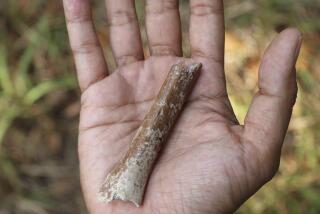Fossils of North America’s smallest dinosaur identified
- Share via
Scientists have identified the fossilized remains of the smallest dinosaur yet discovered in North America, a house-pet-sized creature that would have scurried between the legs of its larger relatives.
The new species, Fruitadens haagarorum, weighed less than 2 pounds and was about 28 inches long, scientists say.
The tiny dinosaur would have been an agile and fast runner, said study coauthor Luis Chiappe, director of the Natural History Museum of Los Angeles County’s Dinosaur Institute. It had to be nimble to survive the hazardous time in which it lived, the late Jurassic period 150 million years ago, which was ruled by giant meat-eaters such as the allosaurus.
The findings, reported by Chiappe and an international team of dinosaur experts, appeared Wednesday in the British science journal Proceedings of the Royal Society B. However, the fossils were actually unearthed in Colorado in the late 1970s. They lay in storage at the Natural History Museum until recently, when they were identified and named as a new species. Partial remains of six individuals have been found.
Fruitadens belonged to an important group of early dinosaurs known as heterodontosaurids, which possessed an unusual combination of teeth, including a canine-type tooth at the front of the jaw and leaf-shaped teeth in the cheek area.
Chiappe said this combination led the team to conclude that this dinosaur probably ate both meat and plants.
In the past, scientists tended to classify dinosaurs as meat- or plant-eaters. Now, however, “we recognize some of them were in between,” Chiappe said.
He said the discovery also offers another view of the ancient world, highlighting the wide range in dinosaur size, “from animals that were barely 2 pounds in weight to animals that were tens of tons.”
There is a bias among dinosaur hunters in favor of the big carnivores at the expense of the smaller animals, he added. That is reflected in museum exhibits: The general public might have the idea from these that all dinosaurs were gigantic.
In fact, “it’s fair to say there were as many small animals as large ones,” Chiappe said. But much less is known about the smaller ones.
The new discovery is now available for public viewing. Visitors to the Dino Lab can view the tiny bones of Fruitadens under a microscope and watch a sculptor re-create the dinosaur’s body.
Fruitadens will also be featured in an exhibit, Dinosaur Mysteries, scheduled to open in 2011.
For more information, visit the museum website at www.nhm.org.
--
More to Read
Sign up for Essential California
The most important California stories and recommendations in your inbox every morning.
You may occasionally receive promotional content from the Los Angeles Times.










